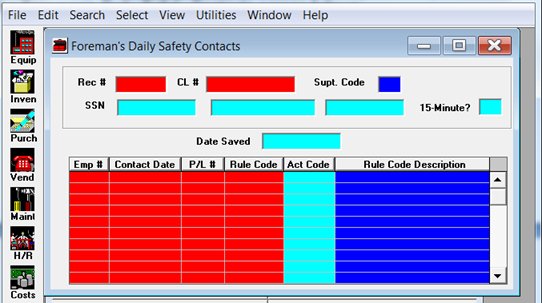Published: May 21, 2012 | Updated: September 12, 2025
Published: May 21, 2012 | Updated: September 12, 2025
Integrating CMMS Software into Effective Safety Programs
 There are 4 elements to an Effective Safety Program:
There are 4 elements to an Effective Safety Program:
- A Commitment from Employees and Management to the Program
- Initial and On-Going Analysis of the Work Areas
- Hazard Prevention & Control
- Safety Training for both Management & Employees
A Successful, Effective Safety Program:
- Focuses on Safety Awareness
- Provides Effective Safety Training
- Reduces the Severity of Work-Related Injuries
- Maintains Constant Communication
- Improves the Morale and Productivity of Employees
- Documents the Company's Efforts
As you can see by the two lists above, there's something for everyone when a company puts a high priority on developing and maintaining a meaningful safety program. We all want to send every employee home at the end of their shift in the same condition as when they started. Another consideration: Depending on the number of employees in your company, you could be obligated by law to maintain and document all aspects of your Safety Program.
Leveraging CMMS for Safety Compliance
The good news here is that most companies that use CMMS Software (computerized maintenance management system software) already have a program in place to satisfy corporate and legal responsibilities for Workplace Safety. Even without OSHA jurisdiction, most companies would maintain an effective Safety Program because it's the right and sensible thing to do.
This article is not intended to focus on establishing a meaningful Safety Program for your company. My intent here is to give you several suggestions for managing your Safety Program using your CMMS Software. Having spent 20 years managing the implementation of MAPCON CMMS Software for a major steel company, I can tell you there are plenty of benefits to doing so.
Our plant employed over 1,500 workers in every aspect of Basic Steel Production from Blast Furnace to Caster through finished, coiled, and coated coils. Exposure to hazards from Fire, Gas, Chemical, Electrical, and Machinery qualified us for OSHA jurisdiction for the management of our Safety Program. Further, we had a list of "mandatory" safety training and topics to document as well. This is where we gained enormous benefits from managing our complete Safety Program using MAPCON CMMS Software.
Integrating Plant-Wide Safety with CMMS
As I mentioned earlier, most companies already have a program in place. Perhaps it's managed by the Director of Safety, but most likely the responsibility is handed down to each individual department. This is where we realized the benefit of spending the time and resources necessary to integrate our plant-wide safety with our plant-wide (server-based) CMMS Software.
We identified every piece of Equipment in every department for the purpose of maintaining our PM program (preventive maintenance), keeping track of costs, and detailing work through the CMMS Software's "Work Order" system. Another essential part of the CMMS Software puzzle is people; who are they – where are they – and what their role is in keeping the equipment running.
Job Safety Analysis (JSAs) and CMMS
At our plant, we called our Safety Procedures JSAs (Job Safety Analysis). JSAs were step-by-step procedures on how to safely complete the jobs required to keep the Equipment running. Each JSA documented the Basic Step(s) of the job, the possible Hazard(s) that could be encountered, and the Procedures and Precautions necessary for safely completing the step.
Our plant had over 3,100 JSAs! They were managed by the respective department owning the Equipment they were written for. The "how-to" of managing these documents was left to the discretion of the Department Head; some used a hand-written form created by the Safety Department while others managed the information in MS Word or Excel. Hard copies of these documents and their annual reviews were sent to the Safety Department where they were kept on file.
Streamlining JSA Management with CMMS
What an Opportunity for Improvement! As each department was brought online with MAPCON CMMS Software, teams were set up to migrate the JSAs into the CMMS Software database in one format. The departments worked off their existing procedure until all the information was entered. As soon as the last department was finished, the Director of Safety had access to every JSA from his desktop PC. No more managing hard copies and the countless file cabinets of old records.
(MAPCON CMMS Software manages a history or "change file" of every record. Revisions made to procedures 5 and 10 years ago are easily recalled for review).
Documenting Compliance with CMMS
Now that we had everyone on a uniform, plant-wide program for Safety, the next step was a critical one; documenting the plant's compliance to the guidelines established by the Safety Department. Quite simply stated – if it isn't documented, it didn't happen!
To accomplish the Documentation phase of the program, we created 3 new Tables in MAPCON's very customizable CMMS Software program. These Tables provided verification of information that would be tracked:
- RULE_CODE_MSTR - Validates the 96 "Rules" used for documenting Safety Contacts
- ACTIVITY_CODE_MSTR - Validates whether the Contact was:
- MT – Mandatory Training
- DR – Department Rule
- PR – Plant Rule
- GS – General Safety Order
- FT – Fire Training vi. GT – Gas Training
- JA – Job Safety Analysis (JSA)
- SAFETY_CONTACT_HIST - Documents the Daily Safety Contacts made by each Supervisor. A screen print of the Foreman's Daily Safety Contacts screen follows:

Benefits of Integrating CMMS into Safety Programs
With the changes implemented to the CMMS Software application mentioned above, the plant was able to realize several important improvements over the previous method of documentation:
- The CMMS Software program is accessible plant-wide. Access to it is managed through a multi-tiered Security Table.
- The Human Resources Table was developed in the CMMS Software to satisfy its needs. The SAFETY_MSTR and three new Tables easily referenced it.
- 100% of the plant's JSAs are now in one format, one location.
- New Reports were written to satisfy virtually every query – whether from an individual Foreman or an OSHA representative during an investigation.
- The historical data is kept forever & can be easily retrieved for reporting.
- The old labor-intensive, legacy system was replaced. Two full-time Keypunch operators were no longer needed.
A previous article written by this author highlighted the benefits of a system that utilizes Zones. This Safety program at the plant is also a benefactor of the Zones feature. The Director of Safety now has access to every Zone (i.e. every JSA, every Daily Contact), where an individual Foreman can only see those records and the employees in his group. This is not a "restricting" feature or policy; it simply speeds up the reports and look-ups requested by those needing the information.
Exploring CMMS Possibilities
It's my hope that this article allows you to look at your own system – your own processes – your own needs and ask the question "Can I do this in my CMMS Software"? If the answer is "Possibly," then what benefits can you gain? Is there a financial saving that can be realized? Can I eliminate redundancy? You won't know until you explore the possibilities.
FAQs
What is a CMMS and how does it improve workplace safety?
A CMMS (Computerized Maintenance Management System) helps track safety procedures, equipment, and training to reduce risks and maintain compliance.
How can MAPCON CMMS support safety compliance?
MAPCON CMMS allows you to document safety activities, manage training records, and maintain OSHA-compliant reports in one central system.
Why should companies integrate safety programs into their CMMS?
Integrating safety into a CMMS improves communication, reduces paperwork, and ensures all procedures and job safety analyses are accessible.
Can CMMS software help manage Job Safety Analyses (JSAs)?
Yes, CMMS software stores JSAs in one format and location, making them easier to update, track, and share across departments.
What are the benefits of using CMMS for safety documentation?
A CMMS keeps safety data secure, accessible, and audit-ready while reducing manual paperwork and administrative costs.
How does CMMS software boost employee morale and productivity?
By improving safety awareness, streamlining training, and documenting procedures, CMMS software helps employees feel safer and more focused on their work.
MAPCON CMMS software empowers you to plan and execute PM tasks flawlessly, thanks to its wealth of features and customizable options. Want to see it for yourself? Click the button below to get your FREE 30-day trial of MAPCON!
Try It FREE!